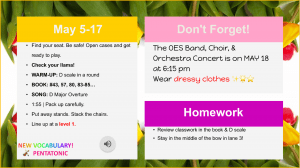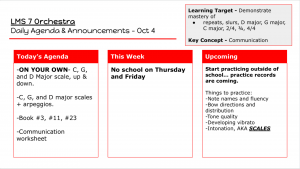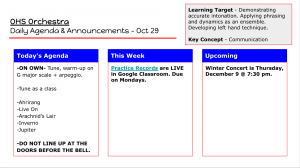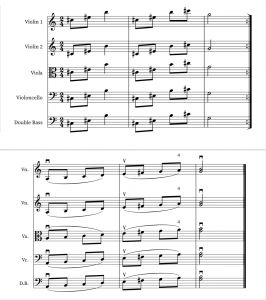The first 10 minutes
I spend a ton of time (more than I care to admit) scrolling social media, and I always find wonderful teacher content to save for later. TikTok is my current favorite online space to find cool new things to try or hot takes to digest. Recently, during a scrolling session, I came across a new teacher asking veteran teachers for their best advice, and it got me thinking about what I would say if asked. I could go on and on about classroom management and music teacher organization, but I think the most valuable piece of advice I have is to have a routine for the first 10(ish) minutes of class.
This applies to classes/rehearsals at all levels. The first 10 minutes can make or break your lesson or rehearsal. If your students enter the room and don’t know what to do or what is expected of them, you are inviting chaos into the mix from the very start. We tend to think of routines as only being helpful for younger students, but I am amazed by how much they help me when I’m planning or when I have to be out for the day. My students can get started on their own and some classes can run themselves. A routine made that possible.
My routine consists of 5 parts: greeting, get ready, agenda, tuning, and warm-up.
Greeting
Some teachers have a special way they greet each student. Some stand at the door. I do a combination because I’m usually fixing instruments or putting out handouts. I try to greet each kid by name. When things are busy, I may skip that step and say a big hello to everyone once we are seated. Either way, my students know I see them and I’m glad they are here. It’s during this time that I take attendance. I do this mentally since I know my students so well, so it isn’t a huge step with a specialized method.
Get Ready
This refers to the time it takes students to come into the room, get their materials, and sit down. During the first few days of school, I model how I want my students to enter the room. Depending upon the grade level, they know where to put their things, how long they have to get their instruments out, and where to look for the day’s tasks.
Agenda
“Getting ready” leads to the agenda that is always on my interactive whiteboard. I have seen many ways to do this and they all work. You just have to choose what works best for you and your classes. I have gone from simply writing everything on the board to creating a slide for each class every day. I prefer this method because the slides serve as my lesson plans while keeping me on track as much as the kids. Furthermore, I share them in Google Classroom so that absent students can see what they have missed.
Here are my agendas by grade level:



I also use agendas to keep students informed of what is coming up during the week or later in the year. Quiz reminders and concert dates get posted early and often during class. Having them on the board allots me time to answer questions and minimizes students not knowing what is happening. Though there is always one that is lost anyway!
Tuning
My tuning procedure varies by grade level. I tune my 5th-grade beginners with some assistance from more advanced students as needed. My middle school students use clip-on tuners once they get to their seats. I keep the tuners clipped to my conductor’s stand so I always know where they are and students return them after they tune. I walk around to help as needed, then check everyone by playing open strings. My high school orchestra tunes itself, though I have had to be more active in that process after the Covid quarantine.
Warm-up
The warm-ups are usually a scale or an exercise from a method book. I have had students do a warm-up on their own as bell work, and then review it as a class before moving on to the rehearsal. Sometimes the warm-up takes more than a few minutes, but it always leads to the rehearsal music. When teaching an arrangement of Jupiter to my high school orchestra, I wrote out a melodic figure for each section and challenged them to come up with fingerings. The sections being in unison helped the violins tune the part they had in the arrangement, and it forced the low strings to play in higher positions.

The slides were posted on the interactive whiteboard and section leaders came up to write their fingerings on the board. I was able to handily work on intonation and bow control because everyone was involved and challenged.
Of course, the first 10 minutes may take longer than 10 minutes, but the sentiment is always the same. Having a routine that students can count on and recreate will get your class off to a great start every day.
